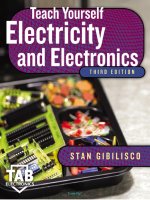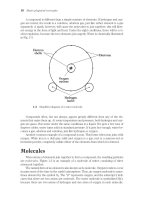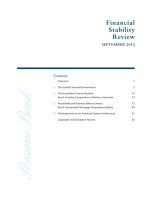nanotechnology and electronics presentation updated september 2011
Bạn đang xem bản rút gọn của tài liệu. Xem và tải ngay bản đầy đủ của tài liệu tại đây (2.72 MB, 25 trang )
Updated September 2011
Applications of
Nanotechnology
in Electronics
Updated September 2011
Electronics and Computers
Nanotechnology Makes:
•
Smaller Transistors
•
Smaller Memory
•
Smaller Circuitry
Updated September 2011
Nanotechnology
in Computer Processing
Moore’s Law
Updated September 2011
Moore’s Law
describes a trend
of technology. It
states that the
number of
transistors that
can be put on a
single chip will
double every two
years.
Wgsimon
cc by WGSimon
Updated September 2011
A schematic diagram of the NIST nanowire transistor.
I
m
a
g
e
f
r
o
m
N
a
t
i
o
n
a
l
I
n
s
t
i
t
u
t
e
s
o
f
S
t
a
n
d
a
r
d
s
a
n
d
T
e
c
h
n
o
l
o
g
y
Updated September 2011
Instead of making
transistor components and
assembling them on a
board, nanoscale
transistors are grown
together on a silicon wafer.
They look much different
from the traditional
transistors.
cc by Ângelo
Antônio Leithold
Photo by Intel
Nano Transistor
Transistors
Updated September 2011
•
The human brain has about 100 billion
neurons.
•
Each neuron has thousands of synapses.
•
The newest processors have only two
billion transistors.
Updated September 2011
Because of
nanotechnology,
the speed of
computers has
increased while
the price of
computing has
decreased.
cc by Ray Kurzweil
Updated September 2011
Nanotechnology
in Memory and Storage
Updated September 2011
This is a 2 gigabyte
hard drive. It
weighs about 70
pounds. It was first
used in the 1980s.
Its cost at that time
ranged from
$80,000 to
$140,000.
Image by HighPoint Learning
Updated September 2011
2 GB in 1980s
$80,000
2 GB in 1990s
$200
2 GB in 2010
$5
Image by HighPoint Learning
Updated September 2011
Current research
shows that by
using
nanotechnology,
1000 GB of
memory can fit
on the head of
this pin. 1000 GB
is 1 Terabyte.
Image by HighPoint Learning
Updated September 2011
Nanotechnology
in Displays
Updated September 2011
Nanotubes are small
enough that they
cannot be seen, so
they can be great
conductors to be
used as transparent
contacts.
cc by Georg Wiora
These layers contain transparent electrodes
Updated September 2011
Carbon nanotubes
on a glass or
plastic sheet
allow
manufacturers to
make clear
conductive panels
for displays that
are extremely
thin.
Image ©LG
Updated September 2011
Image courtesy of Universal Display Corporation
Updated September 2011
Nanotechnology
in Circuitry
How do we see these circuits?
Updated September 2011
To see the
circuitry,
researchers use
an electron
microscope or
an atomic force
microscope. This
image shows
different levels of
a circuit.
Image courtesy Lucent Technologies.
Updated September 2011
Screen Capture image of
In the Nano
Electronics
Activity, you will
download the
virtual
microscope from
the University of
Illinois website. It
allows you to
explore samples
with an SEM and
AFM.
Updated September 2011
This is a
scanning
electron
Microscope
image of an
accelerometer.
You can use the
controls to zoom
in, pan, and take
measurements.
Screen Capture image of Virtual Microscope Software
Updated September 2011
Choose the
integrated circuit.
Change the color
scheme to HSV.
Use the scroll
wheel on the
mouse to zoom in
and out. Toggle
the AFM and draw
a box on the chip
to show the 3D
view of that part
of the circuit.
Screen Capture image of Virtual Microscope Software
Updated September 2011
Drag the scale tool
in the locations on
the chip to record
the measurements.
Drag the height tool
between locations
on the chip to
record the
measurements.
Screen Capture image of Virtual Microscope Software
Updated September 2011
This module is one of a series designed to introduce faculty and high school
students to the basic concepts of nanotechnology. Each module includes a
PowerPoint presentation, discussion questions, and hands-on activities, when
applicable.
The series was funded in part by:
The National Science Foundation
Grant DUE-0702976
and the
Oklahoma Nanotechnology Education Initiative
Any opinions, findings and conclusions or recommendations expressed in the
material are those of the author and do not necessarily reflect the views of the
National Science Foundation or the Oklahoma Nanotechnology Education Initiative.
Updated September 2011
Image Credits
Flexible organic light emitting display (FOLED
TM
) developed by Universal Display Corporation (UDC). Image
courtesy of Universal Display Corporation. Retrieved from
Kurzweil, Ray (Designer). Moore's Law, The Fifth Paradigm. [Diagram]. Wikimedia Commons
(commons.wikimedia.org)
Leithold , Ângelo Antônio (Photographer). Transistor.jpg [ditigal image} Wikimedia Commons
(commons.wikimedia.org)
Wiora, Georg (Designer). LCD-Layers.svg [Digital Image] Wikimedia Commons (commons.wikimedia.org)
WGSimon (Designer), Transistor Count and Moore's Law - 2008.svg [Digital Image], Wikimedia Commons
(commons.wikimedia.org)
Updated September 2011
References
New Design Developed for Silicon Nanowire Transistors. (2005) NIST Tech Beat. Retrieved from
/>Nelson, Max, and Shipbaugh, Calvin. (1995) The Potential of Nanotechnology for Molecular Manufacturing. [Kindle
Edition]. Retrieved from
The Transistor Turns 60. (2007) CNET News. Retrieved from />6222749.html?tag=mncol
Wilson, Michael, Kanangara, Kamali, Smith, Geoff, Simmons, Michelle, & Raguse, Burkhard. Nanotechnology: Basic
Science and Emerging Technologies. (2004). [Kindle Edition] Retrieved from









